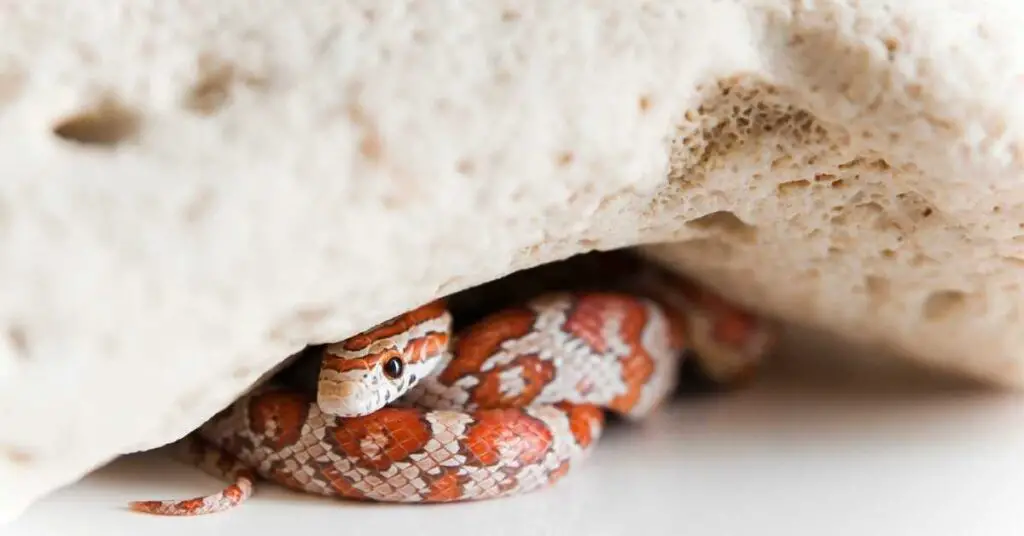Did you know that corn snakes, also known as red rat snakes, are one of the most popular pet snake species in the United States? They are known for their vibrant colors and docile nature, making them a favorite among snake enthusiasts.
But have you ever wondered if corn snakes are nocturnal creatures? Well, the answer to that question is not as straightforward as you might think.
In this discussion, we will explore the natural behavior and habitat of corn snakes, their activity patterns and daily routines, and the factors that influence their activity.
So, let’s dive into the fascinating world of corn snakes and uncover whether they truly are nocturnal.
Key Takeaways
- Corn snakes are crepuscular, meaning they are most active during dawn and dusk.
- They retreat to cool, dark hiding spots during the day to rest and conserve energy.
- Corn snakes use their sense of smell and heat-sensing pits to locate prey.
- Observing corn snakes at night provides insight into their hunting techniques and mate selection rituals.
Natural Behavior and Habitat
Corn snakes exhibit a range of natural behaviors and have specific habitat requirements that contribute to their overall well-being and survival. Understanding these behaviors and habitat preferences is crucial for providing optimal care for these captivating creatures.
One important aspect of corn snake behavior is their reproduction cycles. Corn snakes are oviparous, meaning they lay eggs to reproduce. The breeding season typically occurs in the spring, with females laying a clutch of eggs a few weeks after mating. These eggs are then incubated for approximately 60 days before hatching. During this time, it’s important to provide a suitable nesting site for the females to deposit their eggs, such as a warm, secluded area with appropriate substrate.
In terms of diet preferences, corn snakes are carnivorous and primarily consume small mammals, birds, and reptiles. In captivity, they’re commonly fed thawed rodents, such as mice or rats. It’s important to provide appropriately sized prey items to ensure proper nutrition and prevent any health issues. Additionally, offering a variety of prey species can help keep the snakes engaged and prevent dietary boredom.

Activity Patterns and Daily Routines
Understanding the natural behavior and habitat preferences of corn snakes is crucial for providing optimal care, and this includes exploring their activity patterns and daily routines.
As a corn snake owner, it’s important to know about their sleep patterns and hunting behavior to ensure their well-being and create a sense of belonging in their environment.
- Sleep patterns: Corn snakes are crepuscular, meaning they’re most active during dawn and dusk. During the day, they may retreat to cool, dark hiding spots to rest and conserve energy. At night, they become more active, exploring their surroundings and searching for food.
- Hunting behavior: Corn snakes are skilled hunters, using their keen sense of smell to locate prey. They’re primarily carnivorous, feeding on small rodents, birds, and eggs. They employ a sit-and-wait hunting strategy, patiently waiting for their prey to pass by before striking with lightning-fast precision.
- Daily routines: Corn snakes typically spend their days resting and conserving energy in their hiding spots. They may emerge in the early morning or late afternoon to bask under a heat source, regulating their body temperature. After a period of basking, they become more active, exploring their enclosure and engaging in natural behaviors such as climbing and slithering.
Factors Influencing Corn Snake Activity
Factors influencing corn snake activity can vary depending on environmental conditions, physiological factors, and individual preferences.
Corn snakes, like many other reptiles, are ectothermic animals, meaning their body temperature depends on their environment. This makes temperature a crucial factor in determining their activity levels. Corn snakes are most active when the temperature ranges between 75 to 85 degrees Fahrenheit. They tend to be less active in cooler temperatures and may seek shelter or burrow to conserve heat.
Another factor that affects corn snake activity is light. These snakes are diurnal, meaning they’re active during the day. They have a natural instinct to seek out sunlight to regulate their body temperature. Light also influences their sleep patterns. Corn snakes require a period of darkness to rest and recover. Providing a suitable light cycle that mimics their natural environment is essential for maintaining their activity levels.
Aside from environmental factors, physiological factors also play a role in corn snake activity. Factors such as age, health, and reproductive status can influence their activity levels. Younger snakes tend to be more active and exploratory, while older snakes may be more sedentary. Health issues or reproductive activity can also affect their energy levels and overall activity.
Lastly, individual preferences play a part in corn snake activity. Just like humans, each snake may have its own unique personality and behavior patterns. Some snakes may be more active and curious, while others may be more timid and prefer to stay hidden. Understanding and respecting these individual differences is crucial for providing proper care and a suitable environment for corn snakes.
Observing Corn Snakes at Night
When observing corn snakes at night, it’s important to consider their natural nocturnal behavior and the various factors that influence their activity levels. These factors include hunting techniques, mate selection, and environmental conditions. To truly understand and appreciate the behavior of corn snakes at night, it’s crucial to delve into these aspects.
Hunting Techniques: Corn snakes are skilled predators that use a combination of stealth and agility to capture their prey. They rely on their excellent sense of smell and heat-sensing pits to locate potential meals. Once they’ve identified their target, they strike with lightning speed, immobilizing their prey with their sharp teeth and constriction.
Mate Selection: Like many other reptiles, corn snakes engage in courtship rituals to attract a suitable mate. Males engage in a behavior known as ‘combat dance,’ where they engage in a series of intricate movements and displays to impress females. The successful male then approaches the female and initiates the mating process.
Observing corn snakes at night provides a glimpse into their fascinating nocturnal world. As you witness their cunning hunting techniques and witness the intricacies of their mate selection rituals, you become immersed in their captivating lives. Through these observations, you gain a sense of belonging, connecting with the natural world and appreciating the wonders of these incredible creatures.
Providing Optimal Environment for Corn Snakes
To ensure the well-being and optimal health of your corn snake, it’s essential to create a carefully controlled and suitable environment. Temperature regulation is crucial for these reptiles, as they’re ectothermic and rely on external sources to maintain their body temperature. Provide a temperature gradient within the enclosure, with a warm side ranging between 82-86°F (28-30°C) and a cooler side around 75-80°F (24-27°C). This allows the snake to move between areas to regulate its body temperature as needed.
In addition to temperature, feeding habits must also be considered when providing an optimal environment for your corn snake. These snakes are carnivorous and primarily feed on small rodents. Offer appropriately sized prey, such as mice or rats, every 7-10 days for juveniles and every 10-14 days for adults. It’s important to monitor their eating habits and adjust the feeding schedule accordingly to maintain a healthy weight.
To further enhance the environment, provide hiding spots, such as caves or hollow logs, to mimic their natural habitat. This allows them to feel secure and reduces stress. Additionally, substrate choices should be safe, easily cleaned, and provide proper humidity levels.
Frequently Asked Questions
Can Corn Snakes Be Kept in Groups or Do They Prefer to Live Alone?
Corn snakes can be kept in groups, but there are pros and cons to consider. Group living may provide social interactions and a sense of belonging, but it also requires careful management to ensure their well-being and prevent aggression.
How Long Do Corn Snakes Typically Live in Captivity?
Corn snakes typically live around 6-8 years in the wild, but in captivity, they can live up to 20 years. Common health issues in captivity include respiratory infections, scale rot, and obesity.
Are Corn Snakes Aggressive Towards Humans?
Are corn snakes prone to biting humans? What are the reasons behind their aggression? How can owners handle an aggressive corn snake? It is important to understand the behaviors and needs of corn snakes to prevent aggression and ensure a safe and harmonious relationship.
Do Corn Snakes Require Any Special Lighting in Their Enclosure?
In order to provide appropriate lighting for your corn snake’s enclosure, it is important to consider their lighting requirements. Natural lighting can offer numerous benefits, such as promoting a natural day-night cycle and aiding in their overall sense of well-being.
What Kind of Substrate Is Best for Corn Snakes in Their Enclosure?
When considering the best substrate for your corn snake enclosure, it’s important to choose one that promotes burrowing and retains moisture. Aspen shavings or cypress mulch are both suitable options.
Conclusion
In conclusion, corn snakes are primarily nocturnal creatures, meaning they’re most active during the night.
Their natural behavior and habitat, as well as various factors such as temperature and light, influence their activity patterns.
Observing corn snakes at night can provide valuable insights into their behavior and habits.
To ensure the optimal environment for corn snakes, it’s important to replicate their natural habitat and provide appropriate conditions for their nocturnal activities.


